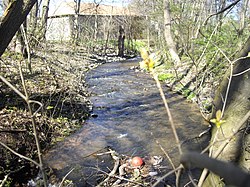포화도(유전자)
Saturation (genetic)유전적 포화도는 동일한 부위에서 동일한 염기서열에서 여러 치환 또는 다른 염기서열에서 동일한 치환의 결과로서,[1] 겉으로 보이는 염기서열 발산률이 실제 발생한 발산보다 낮다.계통유전학에서 포화효과는 가장 먼 계통의 가지 길이가 잘못될 정도로 짧은 가지 끌림을 야기한다.또한 [2]배열에 포함된 계통 발생 정보를 감소시킵니다.
유전적 포화는 미토콘드리아 DNA의 초가변 영역과 같이 빠르게 진화하는 염기서열이나 Y염색체와 [3][4]같은 짧은 연속 반복에서 가장 빠르게 발생한다.
「 」를 참조해 주세요.
레퍼런스
- ^ Philippe H, Brinkmann H, Lavrov DV, Littlewood DT, Manuel M, Wörheide G, Baurain D (March 2011). "Resolving difficult phylogenetic questions: why more sequences are not enough". PLOS Biology. 9 (3): e1000602. doi:10.1371/journal.pbio.1000602. PMC 3057953. PMID 21423652.
- ^ Abylgazieva NA (2003-01-01). "[Case of "renal diabetes"]". Zdravookhranenie Kirgizii. 26 (3): 49–51. doi:10.1016/S1055-7903(02)00326-3. PMID 7903.
- ^ Henn BM, Gignoux CR, Feldman MW, Mountain JL (January 2009). "Characterizing the time dependency of human mitochondrial DNA mutation rate estimates". Molecular Biology and Evolution. 26 (1): 217–30. doi:10.1093/molbev/msn244. PMID 18984905.
- ^ Ho SY, Phillips MJ, Cooper A, Drummond AJ (July 2005). "Time dependency of molecular rate estimates and systematic overestimation of recent divergence times". Molecular Biology and Evolution. 22 (7): 1561–8. doi:10.1093/molbev/msi145. PMID 15814826.


